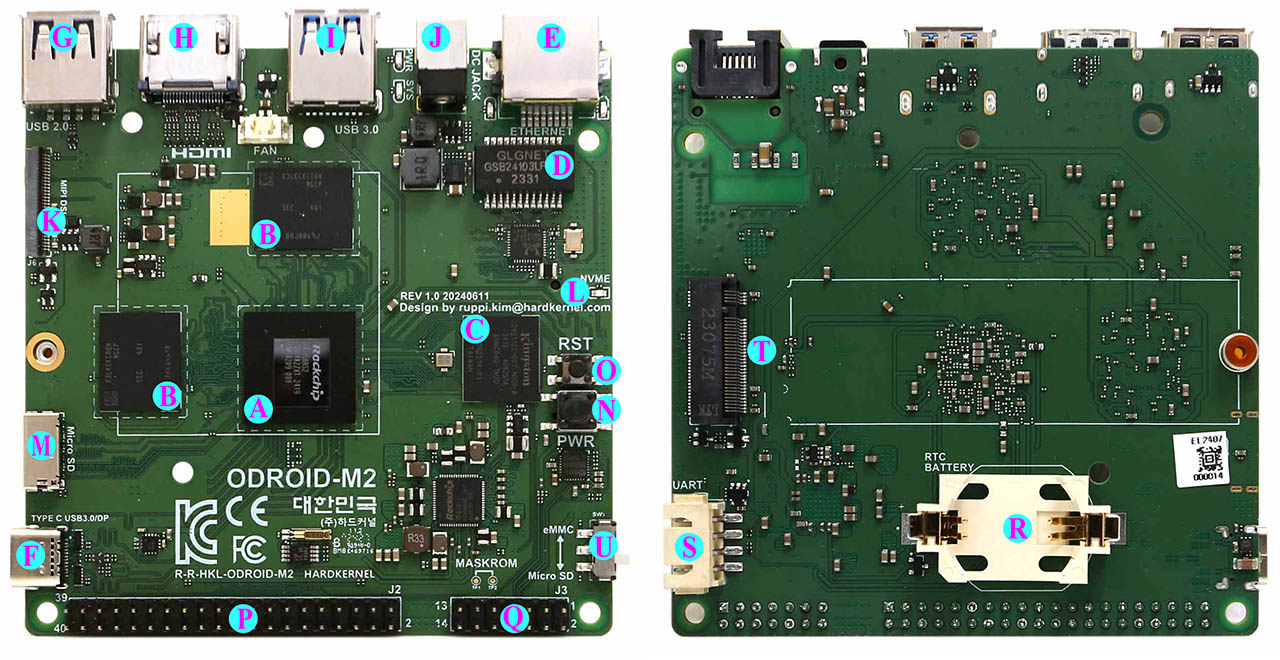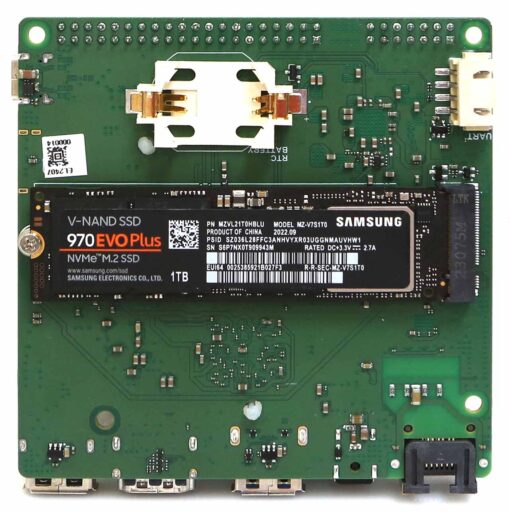ODROID-M2 with 8GByte RAM
Deliveries:
South Africa: Price: R115, 2-4 working days.
International: Contact us for a quote.
Collections:
No Charge - 3 Appian Place, 373 Kent Ave, Randburg Effortlessly bridge legacy and modern technologies with our DB9 to USB Connector, enabling seamless connectivity between serial devices and USB ports.
All items subject to manufacturer's warranty. Extended 12 month warranty available at 20% of purchase price. t&c apply
ODROID-M2 with 8GByte RAM
Multiprocessing performance is about 3 times faster
The ODROID-M2 is a standout high-performance single-board computer (SBC) compared to the M1 series.
We introduced the ODROID-M1 around two years ago, followed by the ODROID-M1S a year later. Both models have been well-received and continue to serve as essential components in embedded systems for our B2B clients.
While feedback indicated that the performance and I/O port configurations of the ODROID-M1 and M1S met the needs of most embedded systems, some customers expressed a desire for higher-end models featuring more powerful processors. In response to the demand for enhanced computing capabilities from key industrial embedded system developers, we are excited to announce the launch of the new ODROID-M2 SBC today.
Compared to the original ODROID-M1, which is based on the RK3568B2 SoC, the ODROID-M2 features the more advanced RK3588S2 SoC, offering the following enhancements:
With its high-speed 64-bit LPDDR5 memory and powerful GPU, the ODROID-M2 delivers impressive graphics performance in a 4K dual-head display setup. We connected two 4K monitors via the HDMI port and the Alt-mode USB Type-C port. This demonstration showcases 4K 3D rendering utilizing hardware GPU acceleration on the first monitor, while the second monitor handles 4K video playback with hardware VPU acceleration. Thanks to the efficient use of hardware accelerators for demanding graphics applications, the cooling fan operates infrequently, as the system generates minimal heat.
- Multiprocessing performance: Approximately three times faster.
- RAM: LPDDR5 64-bit RAM with over twice the memory bandwidth.
- GPU: More than five times the performance of the previous model.
- NPU: More than three times faster.
- Storage: An onboard 64GB eMMC storage device, now twice as fast thanks to the HS400 interface.
The RK3588S2 SoC with multiple high-performance CPU/GPU cores and large cache memory blocks, is manufactured in the Samsung Foundry’s 8N process, and has the advantage of relatively low power consumption compared to performance.
Specifications:
| Form Factor | Board Dimensions: 90mm x 90mm x 21mm Weight: 78g including heatsink, 58g without heatsink |
|---|---|
| Processor | Rockchip RK3588S2 Processor Quad-Core Cortex-A76 (2.3GHz +/- 0.1Ghz) Quad-Core Cortex-A55 (1.8GHz) ARMv8-A architecture with Neon and Crypto extensions Mali-G610 GPU MP4 (1Ghz)64KB L1 instruction cache, 64KB L1 data cache, 512KB L2 cache, shared by Cortex-A76 processor 32KB L1 instruction cache, 32KB L1 data cache, 128KB L2 cache, shared by Cortex-A55 processor L3 data cache: 3MB, shared by 8 processors |
| NPU | 6 TOPS@INT8, Integrated AI accelerator RKNN NPU |
| Memory | LPDDR5 8 or 16GiB with 64-bit bus width |
| Storage | 1 x 64GB eMMC embedded (soldered to the PCB) 1 x Micro SD slot (UHS-I SDR104) * Boot priority between eMMC and microSD can be selected with the slide switch 1 x NVME M.2 SSD (PCIe 2.1 x 1 lane) |
| Networking | 1 x GbE port (RJ45, supports 10/100/1000 Mbps) – LED indicators * Green LED: Flashing by data traffics at 100Mbps connection * Amber LED: Flashing by data traffics at 1000Mbps connection |
| Video output | 1 x HDMI 2.0 (up to 4K@60Hz with HDR, EDID) 1 x MIPI DSI Interface (30pin connector which is different from 31pin of the ODROID-M1) 1 x DP (via USB Type-C port) |
| External I/O | 1 x USB 2.0 host port 1 x USB 3.0 host port 1 x USB 3.0 Type-C (Data communication and DP Alt-Mode, Not a power source/sink) 1 x Debug serial console (UART) 1 x 40 pin GPIO and 1 x 14 pin GPIO |
| Real Time Clock | * On-board very low power PCF8536 RTC chip * CR2032 RTC backup battery holder to keep time and date for near 10 years without main power input |
| Other features | * Power button * Reset button * System LED Indicators: – Red (POWER) – Solid light when DC power is connected – Blue (ALIVE) – Flashing like heartbeat while Kernel is running. Solid On in the u-boot stage. |
| Power | 1 x DC jack: outer (negative) diameter 5.5mm inner (positive) diameter 2.1mm DC input voltage range: 7.5V ~ 15.5V (12V/2A power adapter is recommended) – IDLE : ≃ 1W without any kind of peripherals – CPU Stress : ≃ 7.5W (Performance governor) without any kind of peripherals – Power Off : ≃ 0W |
| A | Rockchip RK3588S2 CPU | K | 1 x MIPI DSI 4 Lanes | |
| B | 2 x LPDDR5 chips | L | 1 x M.2 LED Indicator | |
| C | 1 x 64GB eMMC on-board | M | 1 x Micro-SD Slot | |
| D | 1 x Ethernet Transformer | N | 1 x Power Button | |
| E | 1 x RJ45 Ethernet Port (10/100/1000) | O | 1 x Reset Button | |
| F | 1 x USB 3.0 Type C with Alt-mod DP | P | 40 x GPIO Pins | |
| G | 1 x USB 2.0 host | Q | 14 x GPIO Pins | |
| H | 1 x HDMI | R | 1 x RTC backup battery holder | |
| I | 1 x USB 3.0 host | S | 1 x UART for System Console | |
| J | 1x DC Power Jack | T | 1 x M.2. M-KEY PCIe2.1 1 Lane | |
| U | 1x Slide Switch (Boot mode select) |
On-board M.2 NVMe Slot
If the 64GB of soldered eMMC memory isn't enough, you can expand your storage using an industry-standard M.2 2280 form factor NVMe SSD. The board features an M.2 NVMe slot for accessing larger data storage capacities.
While the ODROID-M2 utilizes a PCIe 2.1 x 1 lane configuration—compared to the original M1's PCIe 3.0 x 2 lanes—this results in a reduction of NVMe transfer speeds to approximately 1/4 of the original. However, we still find that a storage access speed of around 400 MiB/s is adequate for developing various high-end embedded systems. Please note that M.2 SATA SSDs are not supported; the M.2 slot is compatible only with PCIe SSDs (M-Key).
Specifications for ODROID-M2 with 8GByte RAM
| RAM/Memory | 8GB or 16GB |
|
RAM/Memory |
8GB , 16GB |






